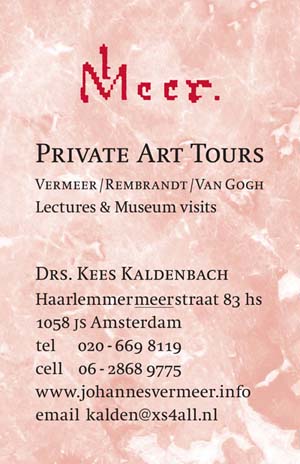 Online Rijksmuseum Visitors Guide - usable for Ipad and Tablets:
Online Rijksmuseum Visitors Guide - usable for Ipad and Tablets:  Online Rijksmuseum Visitors Guide - usable for Ipad and Tablets:
Online Rijksmuseum Visitors Guide - usable for Ipad and Tablets: See the Online Menu of related Mannheimer articles by the same author.
Outstanding art tours in the Rijksmuseum, Amsterdam.
Specific Mannheimer tour in the Rijksmuseum by Drs Kaldenbach.
Updated better web site at www.johannesvermeer.info
==========
Update 23 september, 2018
Visit the Rijksmuseum, walk around with your tablet / smartphone.
For easy reference you may also take a printed Floor Plan which you may obtain for free at the circular desk in the Rijksmuseum atrium.
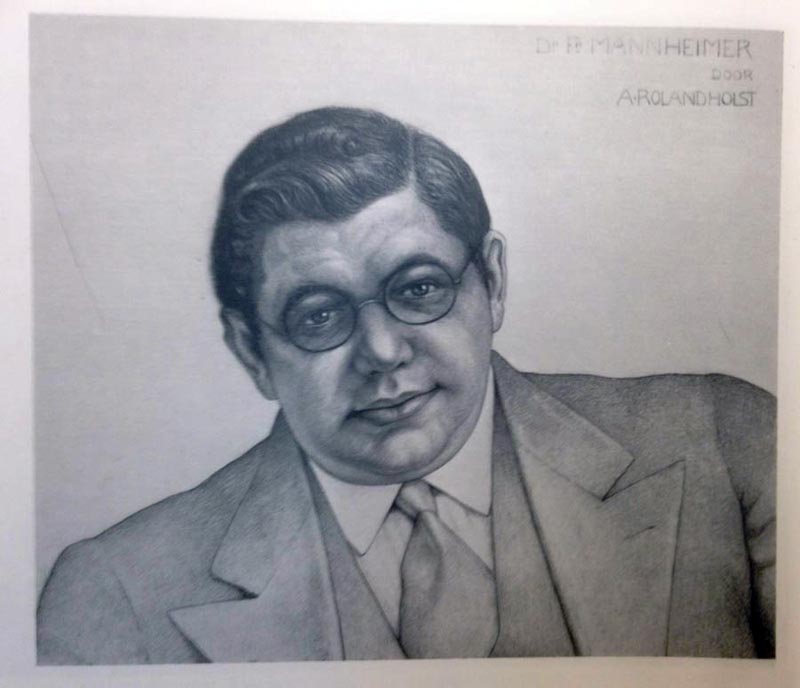 The objects listed below were once owned by the avid and voracious art collector Mannheimer (1890-1939), subsequently bought under duress by Hitler, and at the end of WW2 recuperated from salt mines by the allied Monuments Men, the subject of the impressive movie.
The objects listed below were once owned by the avid and voracious art collector Mannheimer (1890-1939), subsequently bought under duress by Hitler, and at the end of WW2 recuperated from salt mines by the allied Monuments Men, the subject of the impressive movie.
Ownership was unclear as Mannheimer purchased the art not from his private purse but with money from the bank of which he was the main director. In 1952, after some serious wrangling, these objects were officially deposited by the Dutch State in the Rijksmuseum, Amsterdam. It now holds about 98% of the surviving Mannheimer collection. I have ferreted and found out the entire story during 10 months of archival research. See the Online Menu.
My query started from a sense of wonder and amazement after the Rijksmuseum reopened in April, 2013 and hundreds of important exhibited items were for the first time labelled as coming from Mannheimer’s treasure. Full Mannheimer article 9200 words, without notes, or download a separate PDF file included with 130 notes.
The blue timeline-scheme all the way below explains the history of the Mannheimer collection.
Below with every single item you will find inventory numbers. If you desire to read more, do the following: Online, open a new Google page and type Rijksmuseum + the given inventory number. This will yield complete information.
If you want an outstanding presentation: The author is a tour guide, researcher and museum guide and is ready to give you a first-class private art tour of the Mannheimer collection in the Rijksmuseum. You will get VIP entry, and VIP cloakroom service.
Within the Rijksmuseum the Mannheimer objects have been distributed in these floors and rooms:
Basement, Floor Zero, = 0

Room 0.1. The fabulous Elk Antler is located in room 0.1.
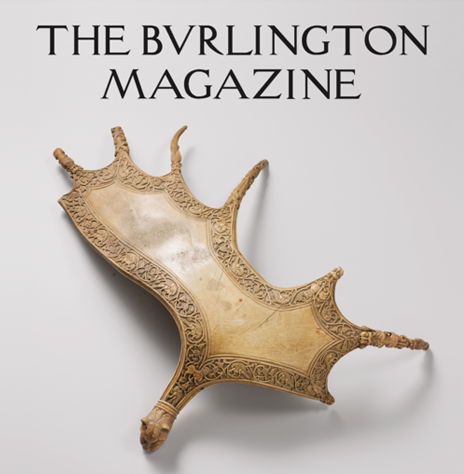 The Elk Antler... Its succession of former owners (the provenance) is flabbergasting: Around 1100 it was added to the rich treasure in the funerary chapel of Louis the Pious (who died 840) in Metz (Louis was the son of Charlemagne). Inv nr. BK-16990.
The Elk Antler... Its succession of former owners (the provenance) is flabbergasting: Around 1100 it was added to the rich treasure in the funerary chapel of Louis the Pious (who died 840) in Metz (Louis was the son of Charlemagne). Inv nr. BK-16990.
Then in 1789 it was looted during the French revolution, bought by a patissier and subsequently purchased by Prince Basilewski in Paris, whose entire art collection was bought by the Tsar for placement in the Hermitage, St Petersburg, but then sold by the Russian state around 1930, in order to buy oil and tractors, ending up in Mannheimer's collection. His bank went bankrupt in 1939 making ownership uncertain.
It was then in the early 1940s bought under duress by Hitler, subsequently recuperated from salt mines by the allied Monuments Men at the end of World War 2.
In 1952, after some serious wrangling, these objects were officially deposited by the Dutch State in the Rijksmuseum, Amsterdam. This Elks antler then was put away in the museum storage rooms until about 2011 when museum curators reviewed most objects left behind in storage.
When the Elks antler was finally correctly researched and identified, it was published in Burlington Magazine, and became one of the most admired and coveted art objects of the Middle ages.

See Mannheimer buying from Russian museums.
See also: Mannheimer art as Jewish property.
..(photo Kaldenbach, 2014).
The horn hanging to the left looks a lot like the one now in the Cluny Museum, Paris, which exhibits the original Roelant Hunting Horn, once owned by Charlemagne, also exhibited in the grave chapel of Louis the Pious in Metz, France.
Room 0.2.
A veritable treasure trove of Mannheimer objects is presented in room 0.2. Not all Mannheimer objects have been fully labeled as such in 2014.
Above an Eucharistic Dove (Pyx), BK-17205..(photo Kaldenbach, 2014) bought by Mannheimer from Russian collections. See Mannheimer buying from Russian museums, which were forced to sell art and antiques by order of Stalin
.
From Limoges, an enamel reliquiary, inv. no. BK-17206 also bought from Russian collections being sold abroad. (photo Kaldenbach, 2014)
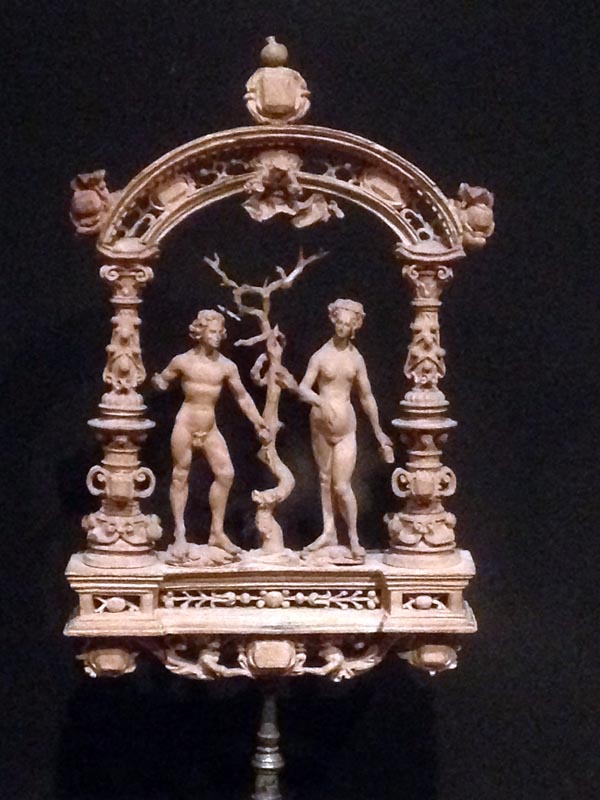
Adam and Eve by the Tree by the south german or Austrian Master IP. Intended as a design for a goldsmith - BK16987

Anonymous, St. Thekla, silver bust reliquary, inv. nr. BK-16997. Valued in 1939-40 at f 30,000.
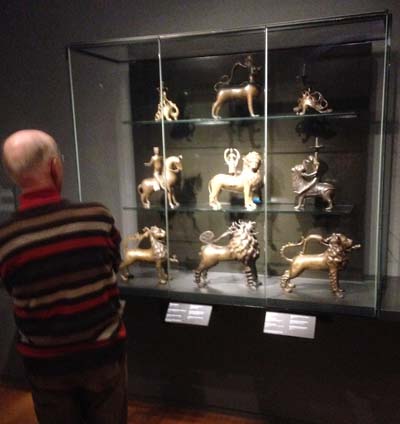 ...(photo Kaldenbach, 2014)
...(photo Kaldenbach, 2014)
 ..aquamanile, inv. no. BK-16910, detail. Photo Rijksmuseum.
..aquamanile, inv. no. BK-16910, detail. Photo Rijksmuseum.
Anonymous, Aquamaniles, a group of bronze water-pouring vessels for washing hands at grand mediaeval tables, including inv. nrs. BK-16910 (top) and BK-16912 (below). ‘The best in this field’. They were valued in 1939-40 at between f 7,000 and f 16,200.
This is the complicated one. In literature, two items were mixed up 1) Man of Sorrows Triptych and 2) Campion Hall Triptych. After a lot of puzzels, it now is clear that this 1) Man of Sorrows Triptych is NOT the one, and the one in Camion Hall was taken out of the rubble after the air attack in London! It is now exhibited in Campion Hall, Oxford.
Below: Lost for the Rijksmuseum. A bomb hit a bank vault in the London Blitz, London: the tryptich is now in Campion Hall. The full story of loss and retrieval is in the hagiography written by H.J.A. Sire, Father Martin D'Arcy: Philosopher of Christian Love, 1997 p. 147-148.
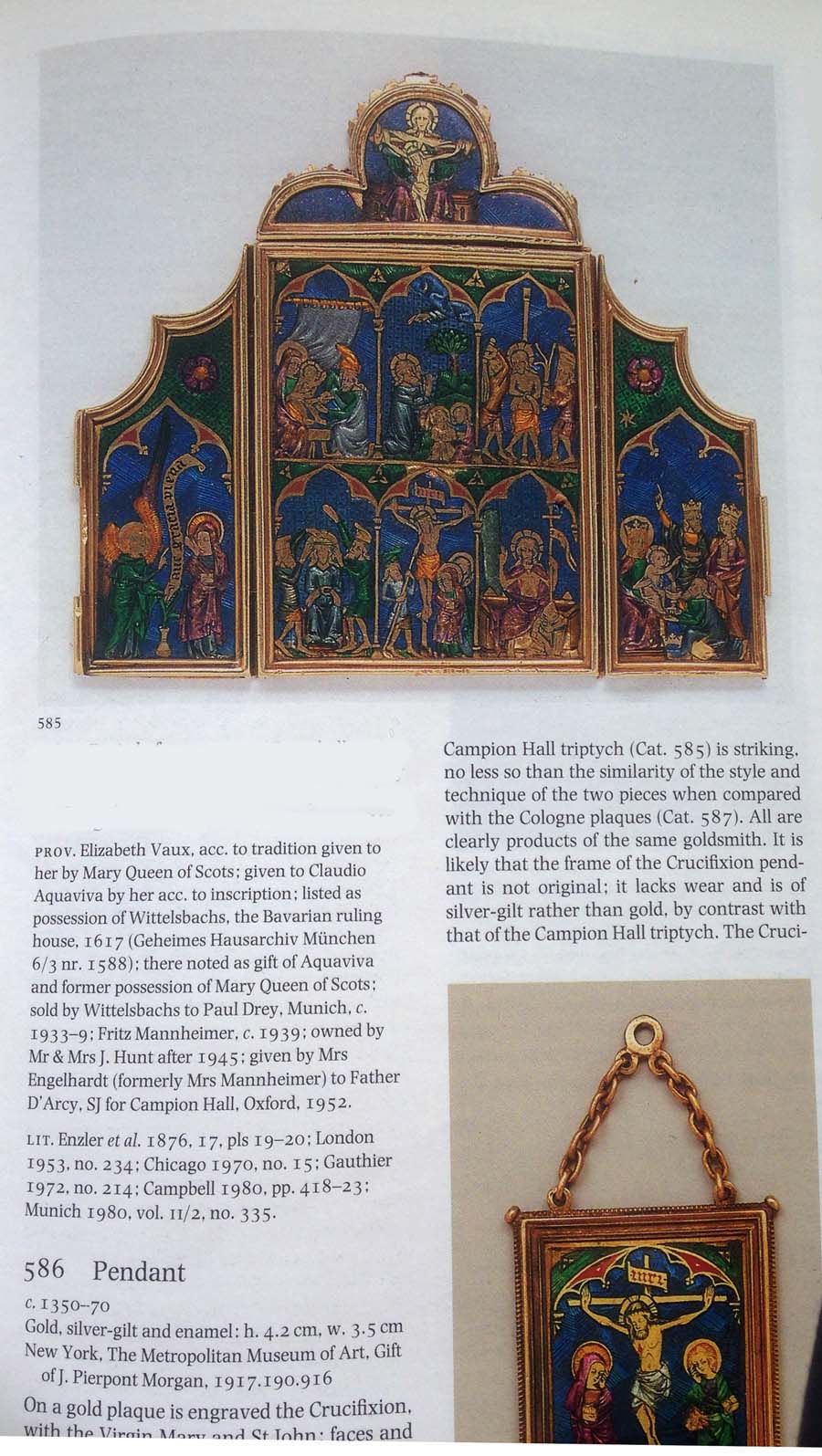
Below. Anonymous, Travelling altar / triptych, Christ as the ‘Man of Sorrows’, ca. 1400, gold and enamel, inv. nr. BK-17045, weight 378 grams (Fig. 6). Valued in 1936 as f 13,500. It was made by a Parisian silversmith who worked for the Royal French Court.

 .
. ..
..
A set of two alabaster Annunciation sculptures, Mary and the Angel (NK124-125) by Tilman Riemenschneider. Rijksmuseum inv. nrs. BK-16986-A and B. In 1939 this set was valued at f 25,000.
Former owners recently contested ownership, but in 2013 the Dutch Restitution Committee, linked to the ‘Commissie Ekkart’ decided against returning the object to the family who had sold it to Mannheimer in 1938. Question: if you were in charge, would you have the Angel's fingers restored? Notice how sparingly Riemenschneider used colour highlights.
Room 0.2, around the corner
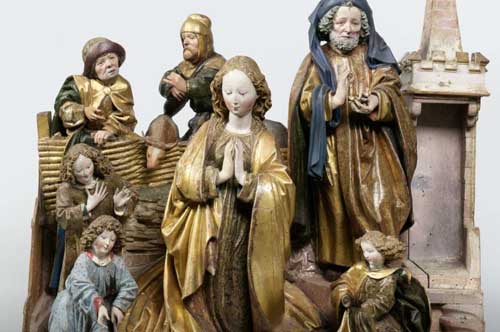
Around the corner. Nativity, sculptural group, c 1470. By (circle of) Kamensetzer, Strassbourg who signed in 3D with a chimney, for chimney builder = Kamensetzer in German.
Inv. no. BK-16985. This Nativity is special in that it shows - for one of the first times in western art history - a sweet grace, humane, interrelated expressive quality, in the style of Nicolaas Gerhaert van Leyden who may have influenced the circle of Kamensetzer. Nicolaas Gerhaert van Leyden is a scuptor whose work is rarely found in museums (a fine one iis in the Chicago Art Institute).
The sculpture has been signed with a chimney (= Kamin). Chimney builder in ancient German = Kamensetzer.
Detail. The original Infant Jesus has been lost in the course of time, and has been replaced (in boxwood?).
 ...(photo Kaldenbach, 2014)
...(photo Kaldenbach, 2014)
One of the few texts on Mannheimer published by the Rijksmuseum prior to the re-opening of the museum after the restoration. Note that there are some errors / misrepresentations / obsfuscations in the text. From: J. Braat et al, Honderd jaar Rijksmuseum, 1885-1985, p. 168.
==============
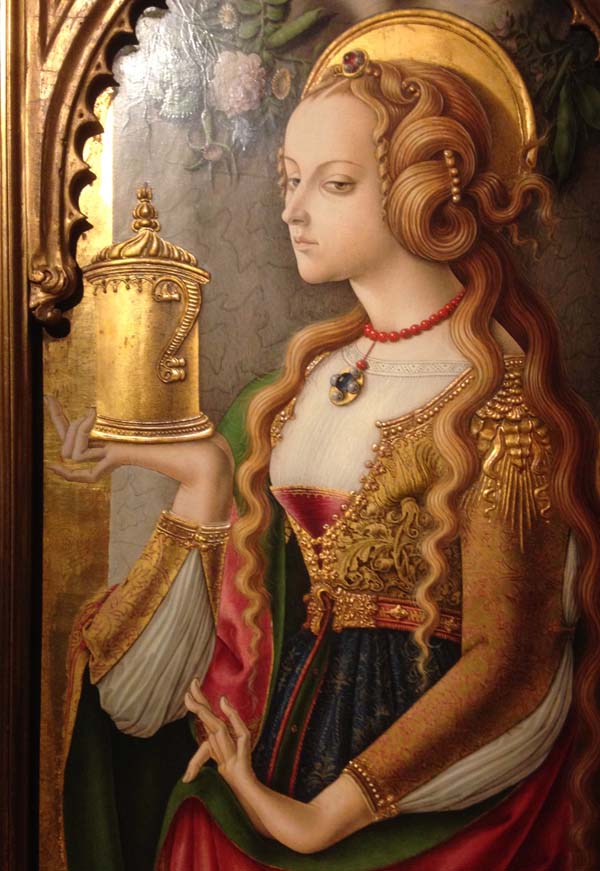 above: ...(photo Kaldenbach .
above: ...(photo Kaldenbach .
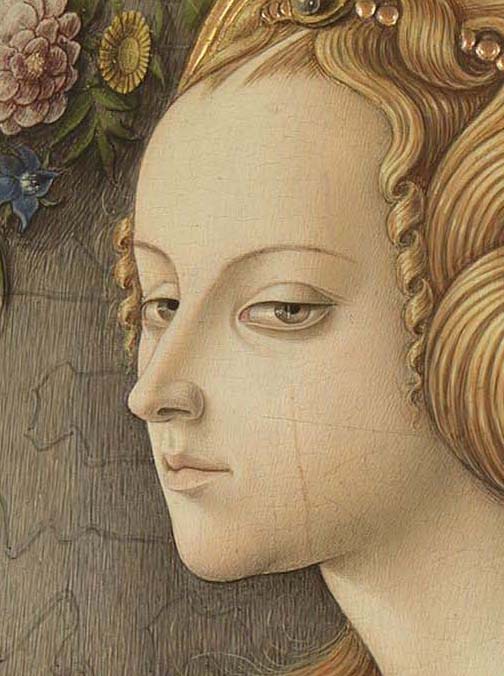
...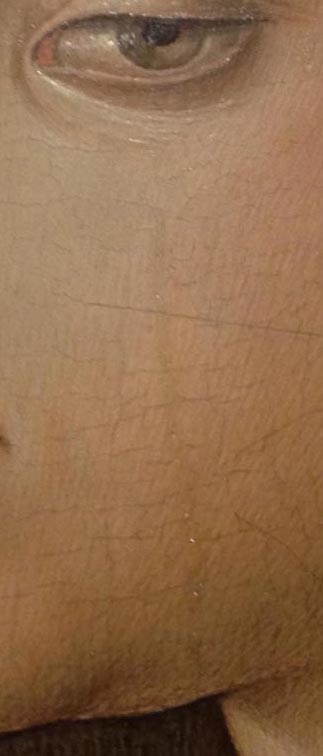
Also in room 0.2, just around the corner, you find the impressive Carlo Crivelli, Mary Magdalen, c. 1480, tempera on panel, 152 × 49 cm, inv. no. SK-A-3989. Post WW2 this was the most coveted painting of all of Mannheimer’s treasures. It took me many viewings + looking against the spotlight to really see her tears flowig down.
The tempera paint (glue based or egg based mixture with colour pigments) has been applied with so much care that it looks like a smooth oil paint, with its seemingly effortless transitions in shadings and hues. The surface has interesting raised parts, giving a 3D effect. Notice the tears running down from her eyes.
Room 0.4.
.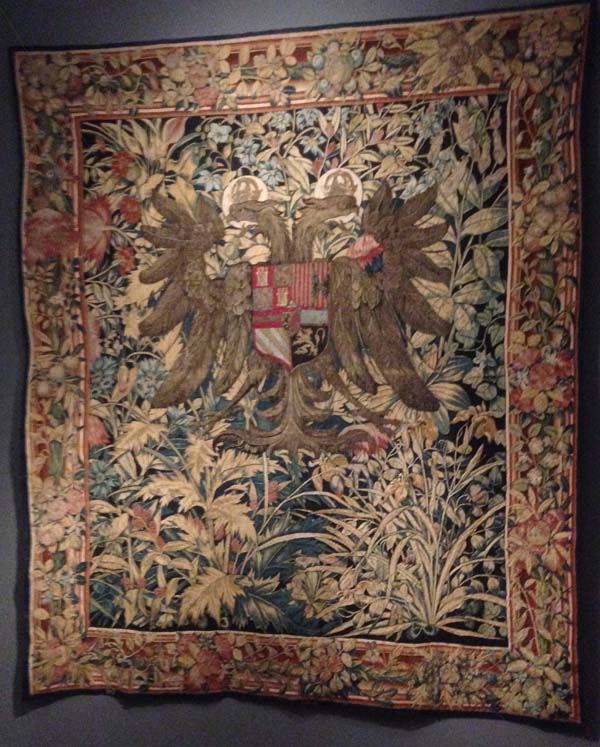 ...(photo Kaldenbach, 2014)..
...(photo Kaldenbach, 2014)..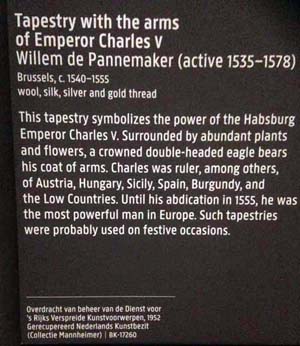
Note the text on the label: "Transfer of custody, 1952,... Recuperated Netherlands art property". Mannheimer is listed because it was Jewish property. From the year 2000 pressure groups have put Jewish property looted by the nazis back into focus. See Mannheimer art as Jewish property.
.(photo Kaldenbach, 2014).
Above: Mannheimer’s family members visiting the Rijksmuseum in 2014, standing by one of the Mannheimer tapestries, BK-17260. Alex Bolen takes a photo; behind Alex is his wife Eliza Reed. More information in the main article: Full Mannheimer article 9200 words, without notes, or a separate PDF included with 130 notes. In a fine example of serendipity I contacted Mr Bolen in his USA office (through the Metropolitan Museum of Art), and he just happened to be in Holland and planning his visit to the Rijksmuseum that week with his family. We obtained VIP treatment in the Rijksmuseum.
Mannheimer Family lineage:
In 1939 Fritz Mannheimer got seriously ill and hired a qualified Brazilian nurse, Marie-Annette Reiss. They soon married. After Mannheimer's death his widow gave birth (in the south of France) to Anne France Mannheimer.
Marie-Annette then married Charles W. Engelhardt Jr. who also adopted Anne France Mannheimer/Engelhardt and after growing up, and after her 1989 second marriage she became known as Annette de la Renta, the American philanthropist and socialite.
Her daughter Eliza Reed married Alexander Lytton Bolen; they and their three sons visited the Mannheimer treasures in the Rijksmuseum in the summer of 2014, and were guided by the present author, and by Rijksmuseum curator Reinier Baarsen.
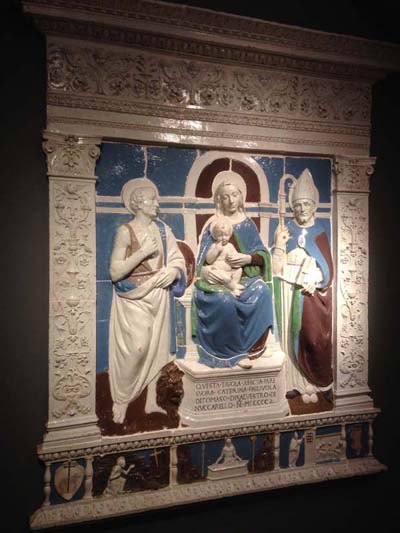 .photo Kaldenbach, 2014.
.photo Kaldenbach, 2014.
Room 0.4. Buglioni, a very large faience wall object, Madonna with saints, a Wall Retable in the style of Della Bobbia. BK-16978. Some 25 years ago it was exhibited as being a Della Robbia.
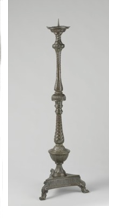
Very tall bronze Candle stand by Andrea del Verrocchio, who was the teacher of Leonerdo da Vinci. BK-16933. Look at its base for the interesting precise date. This type of candle holder was intended for a church or for a grand hall.
======= Rijksmuseum game: Spot The Object in Rooms 0.1 and elsewhere. =========
Below: See what objects were once owned by the Russian prince Basilewski you are able to spot in rooms 0.1 and 0.2. The entire Basilewski collection was bought by the Tsar and entered the Hermitage museum, Leningrad / St Petersburg. When the Russian museums were forcibly selling in the 1930s, Mannheimer bought a minor collection of about 100 items. See Mannheimer buying from Russian museums.

Prince Basilewski's home in Paris. (tip: Elks antler is to the far right. Ornate reliquary boxes to the far left.)
Cassone, anonymous, c 1560-1570. Wood, 73 X183 x 56 cm. The story of David and Goliath is shown. To the short side are the virtures Hope (left) and Justice (right). Made to inspire the bridal couple. Once there may have been two chests, each with a coat of arms, one for the brides family, one for the Grooms family. On Display in ropom 0.5 - 08.
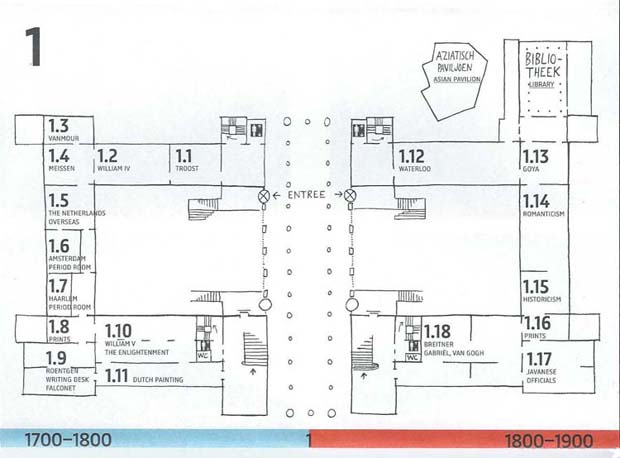
Room 1.6, a veritable treasure of Meissen dinner plates.
..photo Kaldenbach, 2015.
Figurines of Italian theatre, Meissen porcelain.
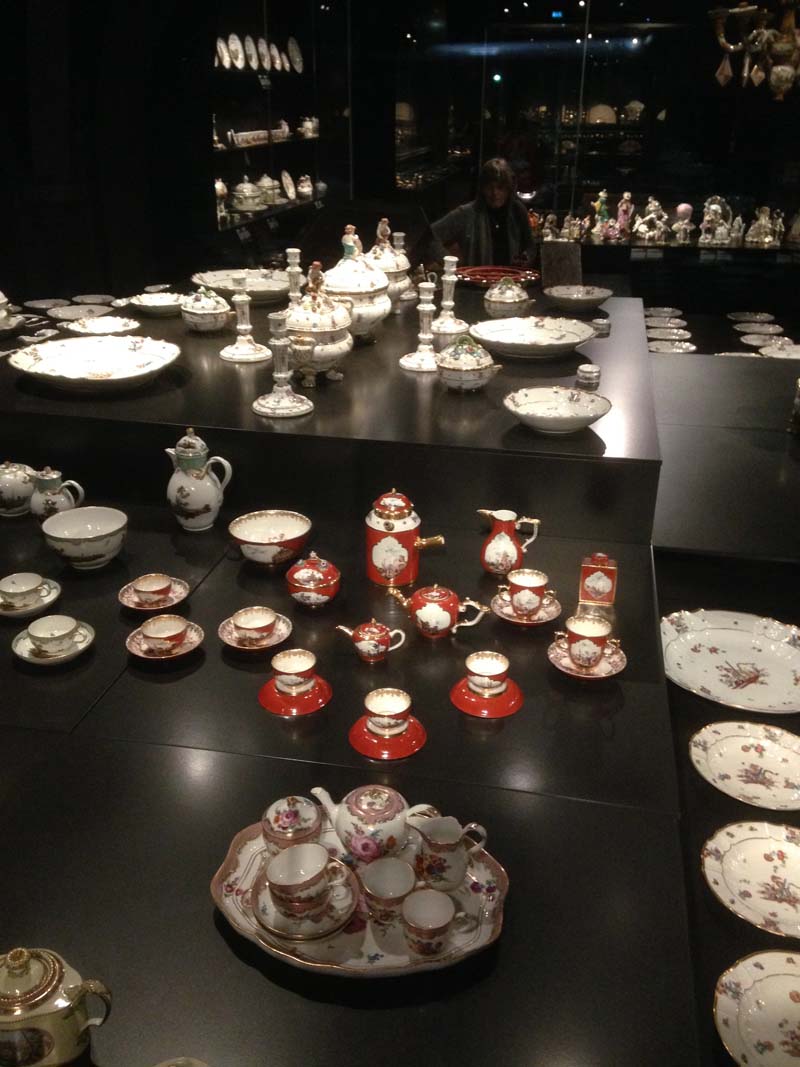 ..photo Kaldenbach, 2014.
..photo Kaldenbach, 2014.
Veritable mountains of Meissen plates, cups, saucers. The set in red is for drinking chocolate milk.
..photo Kaldenbach, 2014.
..photo Kaldenbach, 2015.
A set of cutlery in a fitted box. A ready to travel container with forks, knives etc with Meissen handles. BK-17472
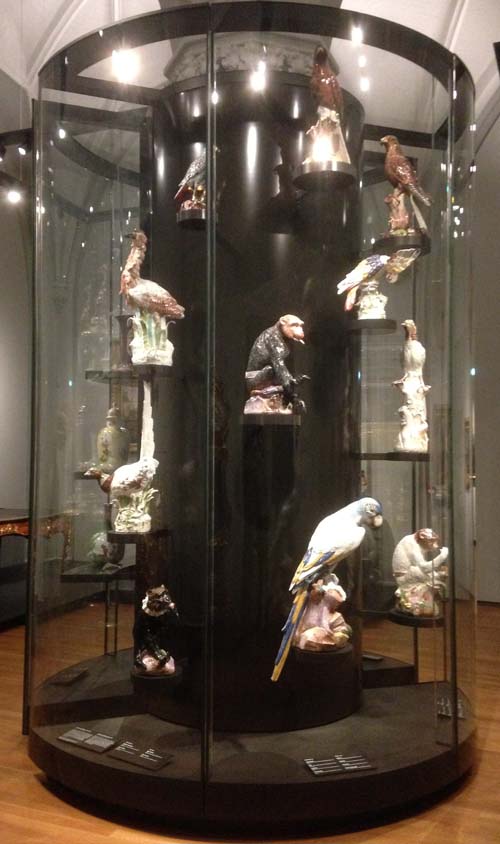 ..photo Kaldenbach, 2014.
..photo Kaldenbach, 2014.
Room 1.4 Meissen animals and birds, according to cognoscenti these are among the very best in the world. Compare the similar works in the story about Mannheimer art collection, nearly entirely perished in the London Blitz.
A number of the Meissen figurine animals in the glass cage above were 'farmed out' to the Gemeentemuseum, The Hague, after 1952, but they were returned to the Rijksmuseum at a later date.
Room 1.4. This Meissen blue-ara, BK-17496, shown in the round showcase above, is just one of the 876 Meissen objects, mostly dinner plates, in the Mannheimer collection of the Rijksmuseum. Outside Germany it is now the major collection in the entire world.
 ..
..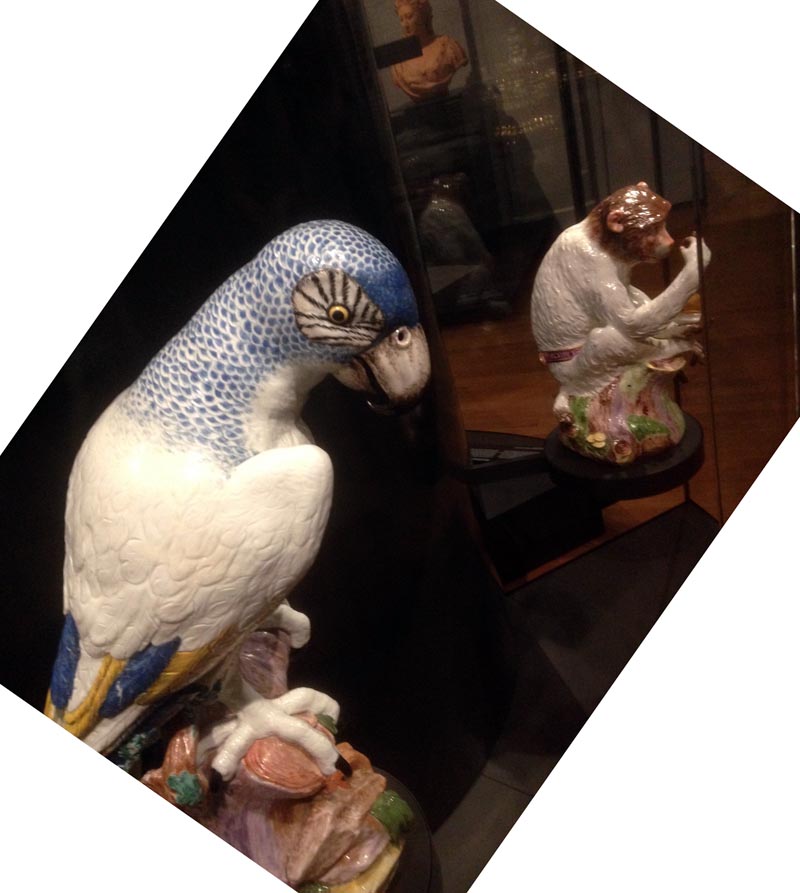 ..photo Kaldenbach, 2015.
..photo Kaldenbach, 2015.
A Meissen work by Osinga, a Meissen Blue Ara, over life size. Inv -BK-17496.
=============
My notes made from Dutch archival material: in Rijksarchief, The Hague, SNK, Bureau Herkomst.
A court document of five pages, dated June 29, 1951 with a history in 34 points, by Mr. Everhardus Korthals Altes to the Judicial Division of the Council for Redress (Raad voor het Rechtsherstel).
page 4
quote:
"that after the London deposited items in a bomb explosion, proved to be almost all destroyed in November 1940, followed by heavy fire in the vault, where these were stored, with the exception of three items, which were sold by the Enemy Property Custodian, and an antique gilded and enamelled travelling altar in the form of a triptych, which apparently was looted and got in foreign hands, and was resurfacing by a collector in Ireland; "
Letter Rijksmuseum on SNK 2 Nov 1948
4 boxes sealed by the Dutch Customs with Mannheimer goods, 27/28 paintings plus drawings, Mannheimer items from Paris. In Paris the collection was stored at Chenue firm, 5 Rue de la Terrasse.
Transferred by military truck/car from The Hague to Rijksmuseum.
Dutch text, my notes:
Pag 4. Mr. Everhardus Korthals Altes
Citaat:
"dat, de na de te Londen gedeponeerde voorwerpen bij een bominslag, gevolgd door hevige brand in de kluis, waarin zijn opgeborgen waren, in November 1940 nagenoeg alle vernietigd bleken te zijn met uitzondering van drie zaken, die door den Enemy Property Custodian te gelde zijn gemaakt, en een antiek verguld en geemailleerd reisaltaar in de vorm van een triptiek, dat blijkbaar door plundering in vreemde handen is geraakt en bij een verzamelaar in Ierland is aangetroffen;"
This is the one in Camion Hall taken out of the rubble after the air attack in London! It is now exhibited in Campion Hall, Oxford.
Below: Lost for the Rijksmuseum. A bomb hit a bank vault in the London Blitz, London: the tryptich is now in Campion Hall. The full story of loss and retrieval is in the hagiography written by H.J.A. Sire, Father Martin D'Arcy: Philosopher of Christian Love, 1997 p. 147-148.

Brief Rijksmuseum aan SNK, 2 nov 1948
4 door de douane verzegelde kisten met Mannheimer, 27/28 schilderijen plus tekeningen Mannheimer afkomstig uit Parijs. In Parijs stond de collectie bij Fa Chenue, 5 Rue de la Terrasse.
Per militaire auto overgebracht van Den Haag naar Rijksmuseum.
=================
Below: Room 1.9.
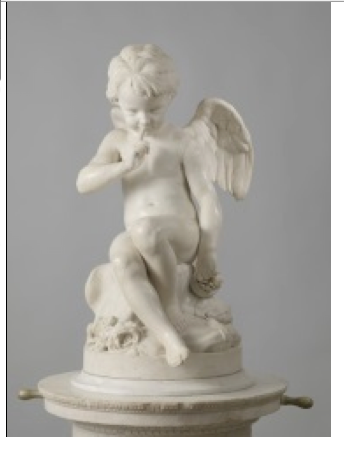
 ..photo Kaldenbach, 2014.
..photo Kaldenbach, 2014.
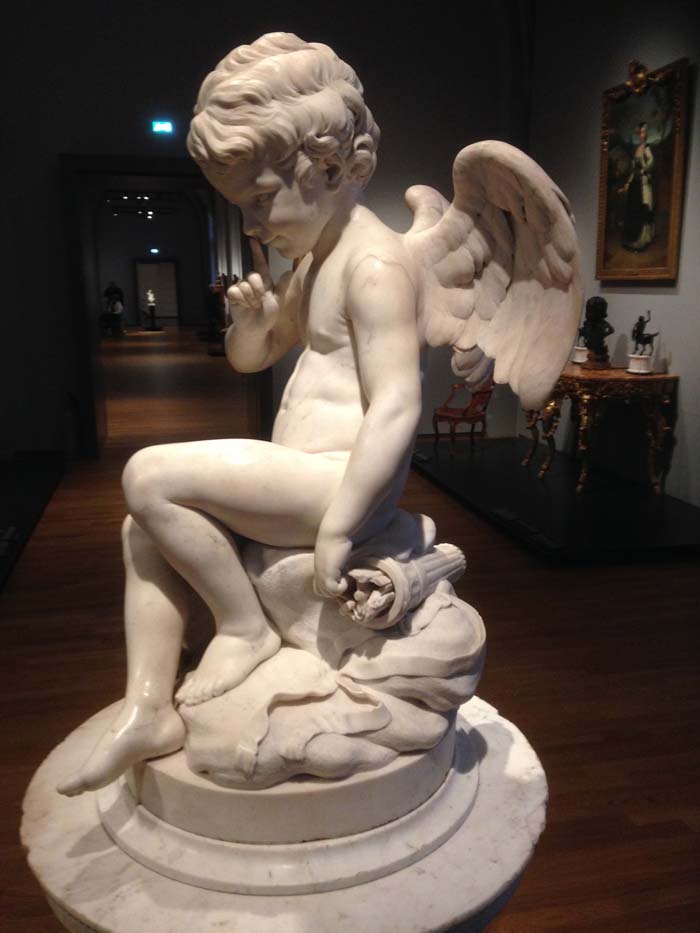 ..photo Kaldenbach, 2014.
..photo Kaldenbach, 2014.
Room 1.9. Etienne-Maurice Falconet, Amour Menaçant, 1757, marble, height 181 cm., Amsterdam, Rijksmuseum, inv. no. BK-1963-101. Bought by Mannheimer in 1933 via an intermediary from the Hermitage Museum for French Franc 1,225,000. (Fig. 2). In 1939 this sculpture was valued - probably way too low - at f 40,000. Once upon a time the base was swivable, obtaining the best possble lighting for the sculpture, but for security purpouses it has now been fixed.
A Voltaire quotation dating from 1731 has been engraved on the sculpture; in translation it reads: "Whoever you are, this is your master: he is it, he has been it or he will be it."
This Amor is telling you to be quiet while he is stealthily reaching for his arrow in order to shoot and make one person fall hopelessly in love. The bow is missing, strangely enough. Executed in marble it would have been very thin and fragile. At the base there is one rose still in the bud but one rose open and blooming.
In art history this sculpture has become famous through many prints, marble copies, reduced copies in marble, bronze and Biscuit de Sevres porcelain, and even once as part of a painting (Fragonard, The Swing, Wallace Collection, London). There are five full size marble copies known (one in Louvre, Paris, and one still in Hermitage, St Petersburg). This one in Amsterdam is however the one and only original, with a fitted marble base and the maker's signature.
Etienne-Maurice Falconet (1716-1791) made his career as a sculptor in Paris, France. In 1755, just after he became member if the Royal Academie, a terracotta model of this Amour Menaçant was exhibited in the 'Salon' exhibition of living artists in the Louvre, Paris. A student of Jean-Baptiste Lemoyne, Falconet also studied philosphy and languages. Denis Diderot, editor if the Encyclopedie, became his friend. Falconet was asked by Diderot to write the tekst entry on sculpture in the Encyclopedie.
Another version is exhibited in the Louvre:
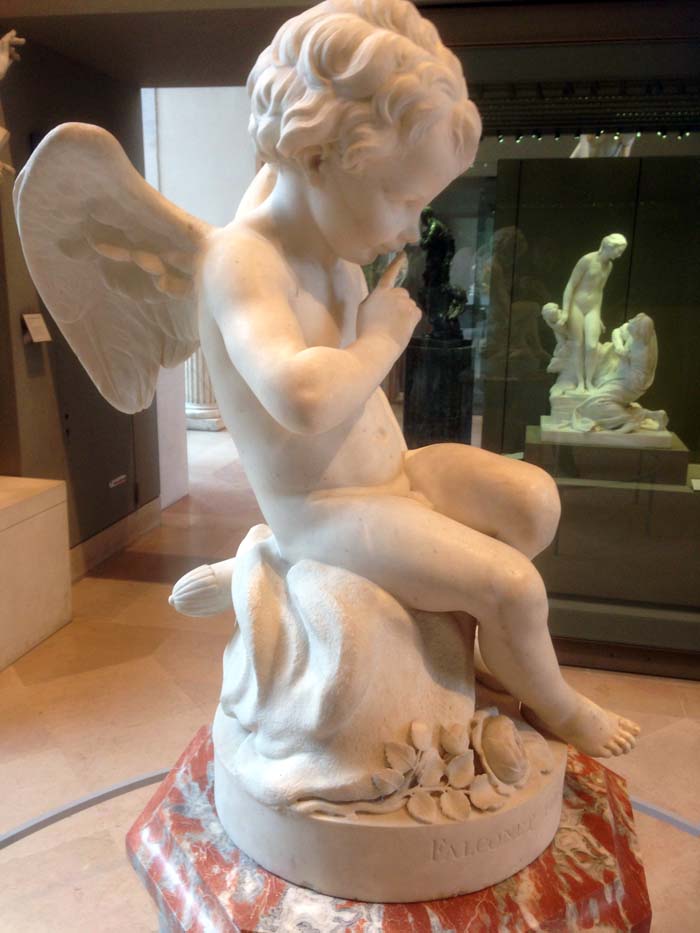
Above: Etienne-Maurice Falconet, Amour Menaçant, 1757,the version exhibited in the Louvre, Paris, 2015.
 ..photo Kaldenbach, 2014.
..photo Kaldenbach, 2014.
Room 1.9. A group of Mannheimer objects, in the Rijksmuseum. Foreground: snuffboxes. Background: the incredible and miraculous fold-out writing desk by A. Röntgen.
In the other parts of the same large room is French furniture, also considered among the best in the world.
Reflected above in the glass case is the Falconet’s sculpture. Photograph by the author. The desk is normally closed, because visitors would be tempted to explore all secret drawers and spaces. See the link above for many more images of the open cabinet. Click: the astounding, exquisite fold-out desk by Roentgen. It would be a tremendous improvement in teh Rijksmuseum if a protective glass case would be installed and the desk would be shown in its full glory, entirely openend up for the public as shown below.
This item was transported to the Metropolitan Museum of Art for an exhibition about the superstar pieces of german furniture making. This one by Roentgen was the superstar. It was shown OPENED as it should be.
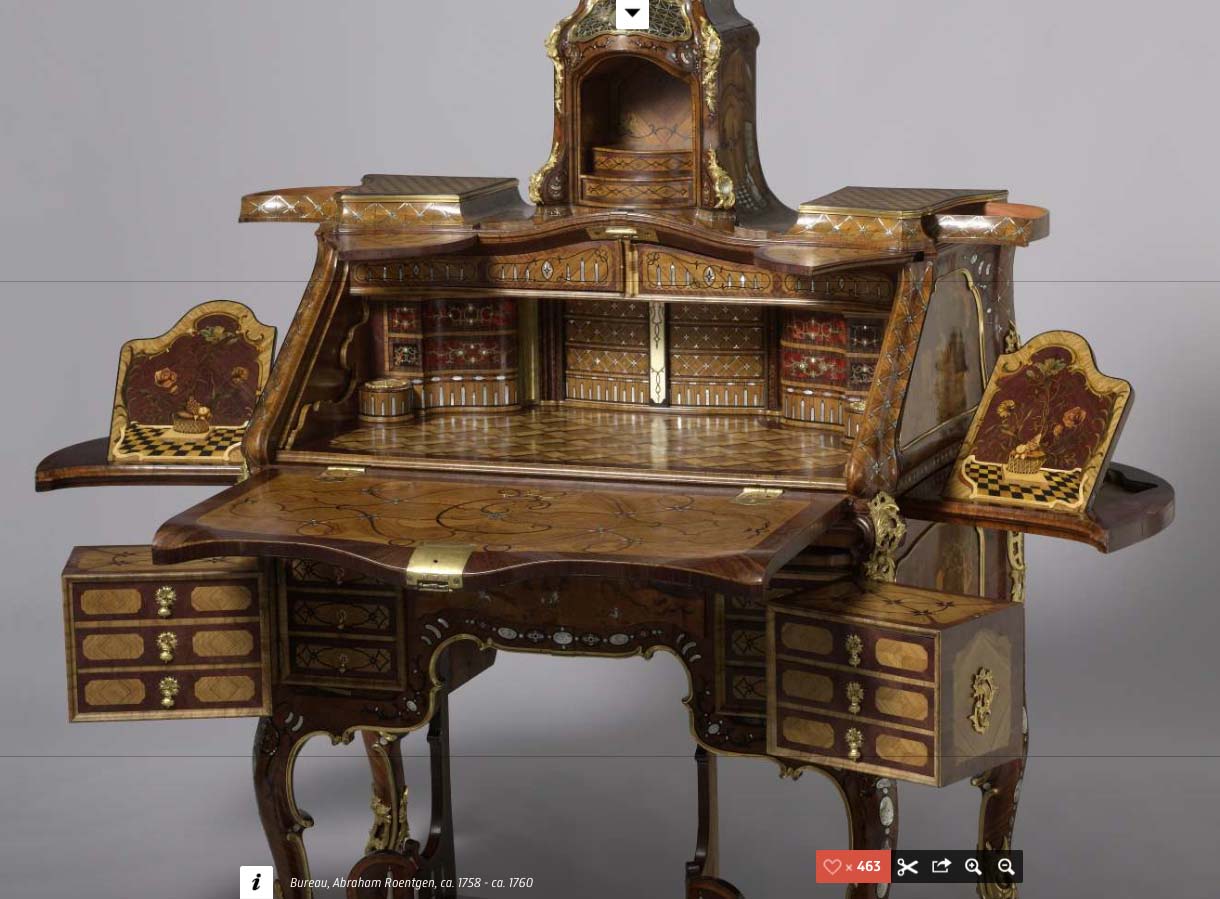
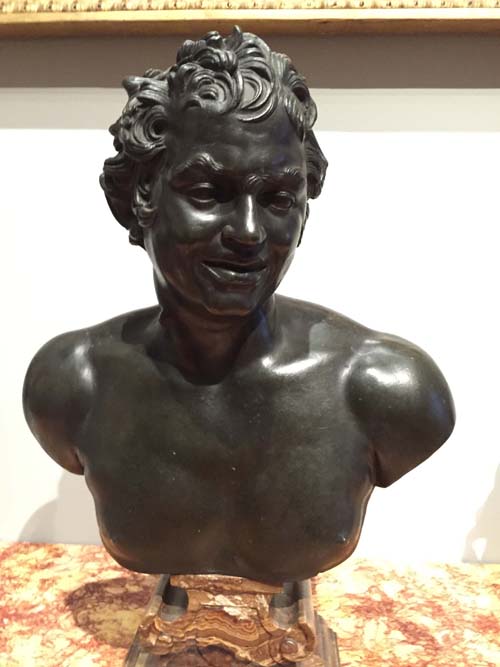
Bust of The Laughing Albani Faun by Valadier, circa 1775, bought there as an expensive souvenir by the first buyer. Bronze and Alabaster. BK 16945. Photo Kaldenbach, 2015.
Look at the text sign: The date of entry in the museum, 1960, is really mystifying and unexplained. Almost all objects formally entered the collection in 1952 although most were already shipped there by the late 1940s. Perhaps the text is referring to the legal transfer of property from the state to the Rijksmuseum in 1960 ?
Note: After the recuperation of about 3000 items from Mannheimer's treasure from salt mines by the Allied Monuments Men in 1945, talks took place in 1946-1947 in a small
committee between Ministries and Dutch museum directors over which museum would receive which recuperated art objects.
Several directors of major museums may have visited the Rijksmuseum cellars and museum rooms, where the Mannheimer treasure was partly stored and partly exhibited.
Perhaps they also went through many boxes and baskets kept in The Hague in the buildings of the Ministry of Finance, which were stored there up to 1948.
For the entire riveting story, read the main Mannheimer article.
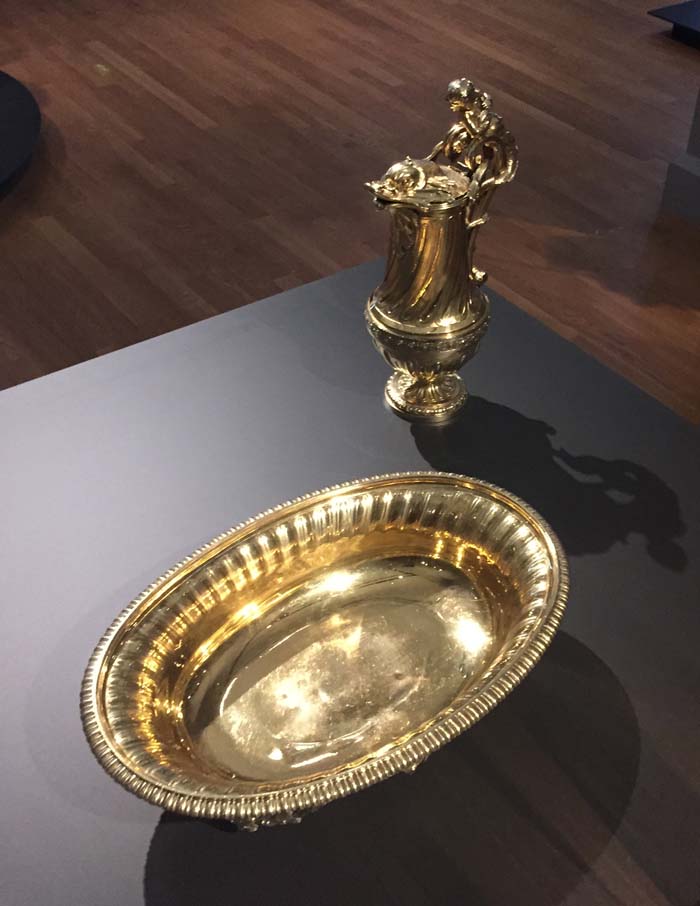
BK-17020-a
Ewer and chalice, presented by the spanish king Carlos III to his daughter in law.
Silversmith: Thomas Chancellier, Paris 1765, after a design by Philippe Caffieri.

BK-16653. Secretary - writing desk with drop-front, Paris ca 1790, attributed to Adam Weisweiler. Contains a 17th C Japanese lacquerwork panel, an early form of art object recycling.
Below: walk to the other wing of the museum shows objects bought in Russia around 1930 ... Room 1.13
.(photo Kaldenbach, 2014).
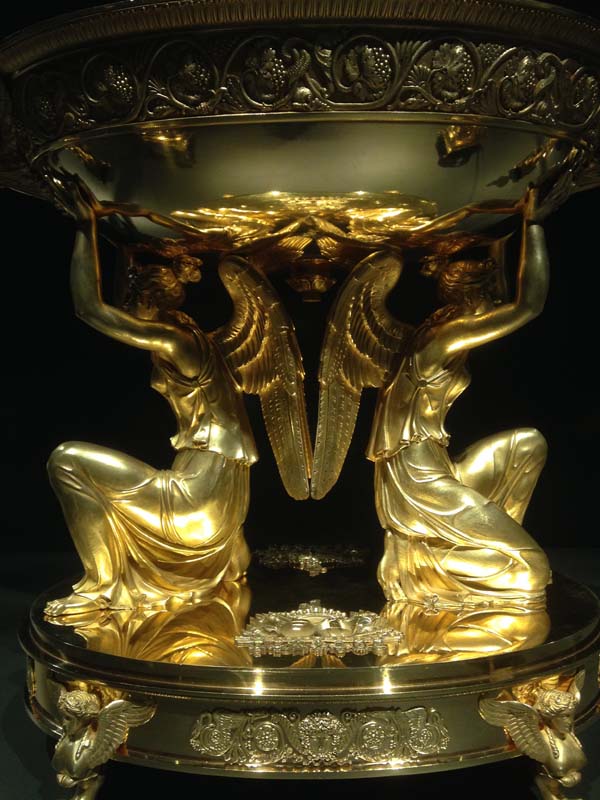 .(photo Kaldenbach, 2014).
.(photo Kaldenbach, 2014).
...
(photo Kaldenbach, 2014).
.(photo Kaldenbach, 2014).
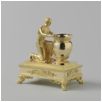
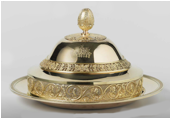
Room 1.13: A large Russian table setting of silver and gold, Imperial splendour.
Above, to the left: J.B.C. Odiot, Mustard container with kneeling sculpture of a female in antique dress, silver gilt, Empire style, inv. nr. BK-17039, valued in 1948 at f 100,000.
To the right: J.B.C. Odiot, Mustard container, silver gilt, with Potemkin coat of arms, inv. nr. BK-17035-A, also valued in 1948 at f 100,000.
A discussion is in the book Rijksmuseum 1800-1900, pages 92-95. The highly sculptural table setting was completed in may 1819 for the Alexandra Vasilievna Engelhardt (1754-1838), who had just become a widow of count Branicki. She was a favourite court lady to Tsarina Catharina the Great. Before being shipped to Russia, it was exhibited in Paris and the maker, Odiot again got a gold medal.
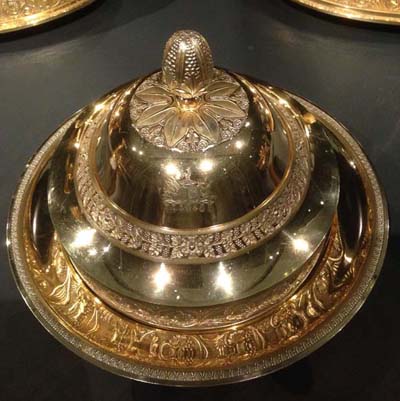 .(photo Kaldenbach, 2014).
.(photo Kaldenbach, 2014).
An object with the Potempkin coat of arms.
Further reading: Mannheimer buying from Russian museums, which were forced to sell art and antiques by order of Stalin
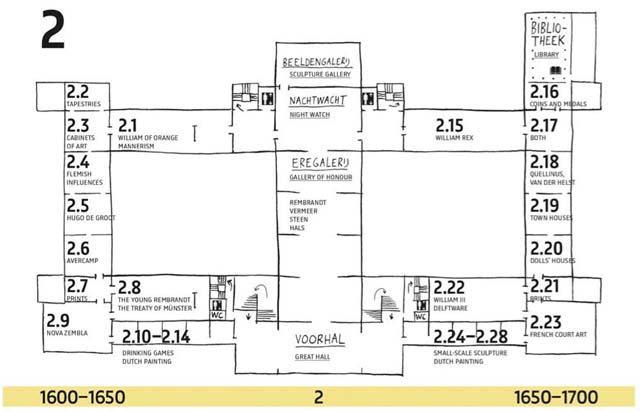
Room 2.3 : Cabinets of Art theme.
The most spectacular object in this room is the Merkelsche Tafelaufsatz, by Wenzel Jamnitzer. It shows Mother Nature in a setting that is hallucinatingry real. By the foot of the object you see insects, lizard, flowers that have been cast from real live specimens. In the casting process of hot, liquid silver they sadly died.
It was Adolf Hitler's prize posession out of the 3000 objects in the Mannheimer Collection that he bought during WW2.
 . photo Rijksmuseum.
. photo Rijksmuseum.. Photo taken from Internet.
Above: Rijksmuseum, Amsterdam. Room 2.3: Wenzel Jamnitzer, Merkelsche Tafelaufsatz, 1549, inv. nr. BK-17040-A. It basically is a fruit stand, to hold the fruits of Mother nature.
This entirely over-the-top, outrageous, exquisite, highly ornamented silver table-top art object is now considered one of the world’s high points in silver-smithing. It was valued in 1939/40 at f 100,000.
More text and various large images by Kaldenbach: Mannheimer's -Jamnitzer-Merkelsche Tafelaufsatz
Read A serious article on this object, in German by Klaus Pechstein, in PDF.
Parents and lovers: lift small and medium persons up to look at the inside of the chalice. It is worth it. We are still waiting for mirrors to be placed on top. Or take a photograph with a camera held very high.
Below: Room 2.3 : Visitors in the Cabinets of Art room. Nearly every object stems from the Mannheimer treasure.
(photo Kaldenbach, 2015)
Panorama inside the room almost entirely filled with Mannheimer objects. .(photo Kaldenbach, 2014).
Rock crystal objects in all shapes and sizes. Some with added ornaments in gold, enamel etc. This Coupe below, attributed to Dionysio Miseroni, is BK-17098.
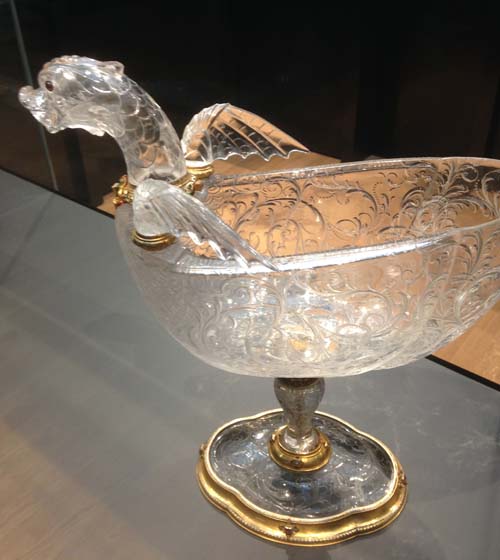 .(photo Kaldenbach, 2014).
.(photo Kaldenbach, 2014).
.(photo Kaldenbach, 2014).
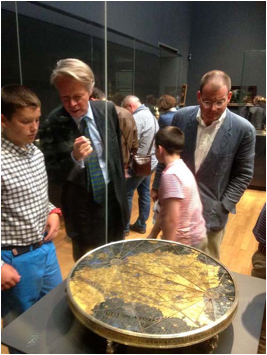 Room 2.3: Mannheimer’s family members visiting the Rijksmuseum in 2014, standing by the circular Mannheimer art object, BK-17007.
Room 2.3: Mannheimer’s family members visiting the Rijksmuseum in 2014, standing by the circular Mannheimer art object, BK-17007.
To the left curator Reinier Baarsen explains this rock crystal map of Spain + Portugal to one of the sons. Their father Alex Bolen stands to the right. (see Mannheimer family story explained in floor 0).
This exquisite table object was restored in Germany by a restoration specialist who knew how to handle behind-glass or crystal art objects.
(The original craftsman or artist applied this golden map directly on a sheet of rock crystal, and we see it now upside down through the layer of crystal). Initially the area of the sea, now grey, was pure blue, from the costly ultramarine / lapis lazuli. Attributed to Augustin Hirschvogel or Wenzel Jamnitzer.
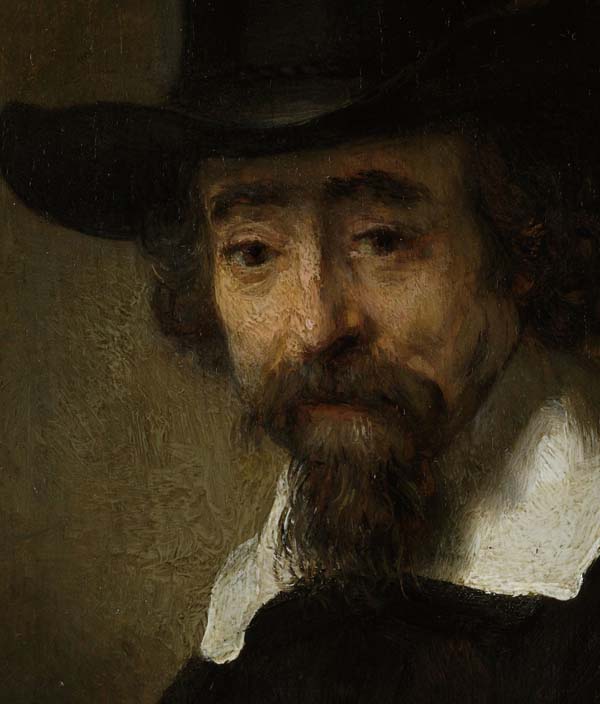
Rembrandt, Portrait of a man, probably Dr Ephraim Bueno (detail), inv. no. SK-A-3982. Not on show in the Rijksmuseum at the moment. It is a sketch in oil, made in preparation for the etching that was produced by Rembrandt.
Riddle: where is this one situated? I have not seen it anywhere exhibited in decades... Why ??
Below: Stolen object!

J.A. Houdon, Voltaire Seated at Age 84, bronze gilt sculpture, from the Hermitage, inv. nr. BK-16932, valued in 1948 at f 45,000. It was stolen from the Rijksmuseum in 2000, and is still missing. If you spot it anywhere on the art market, please alert us! Voltaire sat as a model for Houdon in 1778.
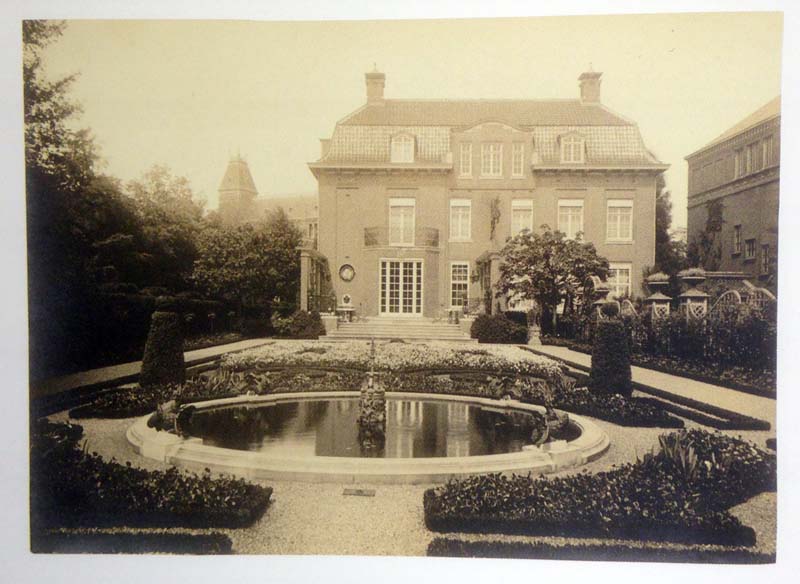
Mannheimer lived just behind the Rijksmuseum, at Hobbemastrat 20, in a building then nicknamed Villa Protski (Villa Gaudy). Photo by Hanna Elkan in Rijksprentenkabinet.
=========
New information, 2016, provided by Radboud van Beekum: Hanna Elkan (1893 Berlin - 1967 Santiago de Chile) kwam, waarschijnlijk via contacten met kunstenares Else Berg, in 1924 naar Nederland. In die tijd fotografeerde zij o.a. danseres Gertrud Leistikow. Toen zij zich in 1928 definitief in Amsterdam vestigde, aan de Van Baerlestraat 80, kreeg zij al gauw naam als portretfotograaf, voor mensen uit de muziek- (Bruno Walter, Igor Stravinsky) literatuur- (Simon Vestdijk, Victor van Vriesland) en toneelwereld (Paul Huf sr., Erika Mann). Zij verkeerde in kringen rond Leistikow, Berg, Architectura et Amicitia, Paul Huf sr., ed. In 1930 kreeg zij van bankier en kunstverzamelaar Fritz Mannheimer de opdracht het interieur van zijn huis aan de Hobbemastraat 20 vast te leggen. De 51 opnamen werden gebundeld in een album dat zich thans in het Rijksmuseum bevindt.
Radboud van Beekum
Historisch onderzoek
Further reading, with a major article with 130 notes online: http://kalden.home.xs4all.nl/mann/Mannheimer-menu.html
Final remarks:
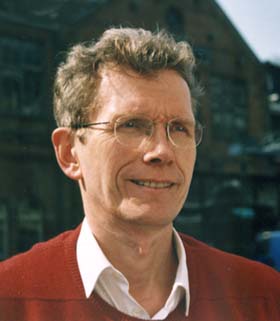 With hindsight the Dutch museums - other than the Amsterdam Rijksmuseum - did not receive their allotted 20% part of the remaining Mannheimer treasure in 1952.
With hindsight the Dutch museums - other than the Amsterdam Rijksmuseum - did not receive their allotted 20% part of the remaining Mannheimer treasure in 1952.
No archival document has yet surfaced to explain why the Rijksmuseum in the end was to keep about 98% instead of the intended 80%. One may consider that the body of the entire Dutch museum collections put together (called Collectie Nederland) may in the end have been optimally furthered by the concentration in one place, the Rijksmuseum. Having received this outstanding applied art collection, it gained leverage to acquire more related high quality objects.
After the recuperation in 1945, the Dutch State had already ordered the auctioning off of the less valuable remainder in 1952. The first Mannheimer auction had already taken place during the Nazi occupation of the Netherlands; secondary quality items were then sold off.
Scheme below explains the history of the Mannheimer collection.
In 1952, the remaining parts of the Mannheimer treasure not allocated to Dutch museums were also auctioned off in Amsterdam. The proceeds went to the remaining creditors from the 1939 surseance of the bank, and perhaps also to the Dutch state for taxes. The sale was comprised of 476 numbered items. Objects ranged from a large terracotta wall object by Della Robbia that went for f 6,000 to much lower prices for minor items. In the furniture section the highest prize was for a set of matched furniture for f 24,500. One tapestry reached a high of f 6,200, and one bronze lustre object fetched f 45,000. The highest runaway price was for a set of 24 ‘vermeil orfevri’ plates, 25 cm in diameter that went for a stunning f 340,000. However, most of the prices for the 476 sold items lay much lower, in the range of a few hundred guilders.
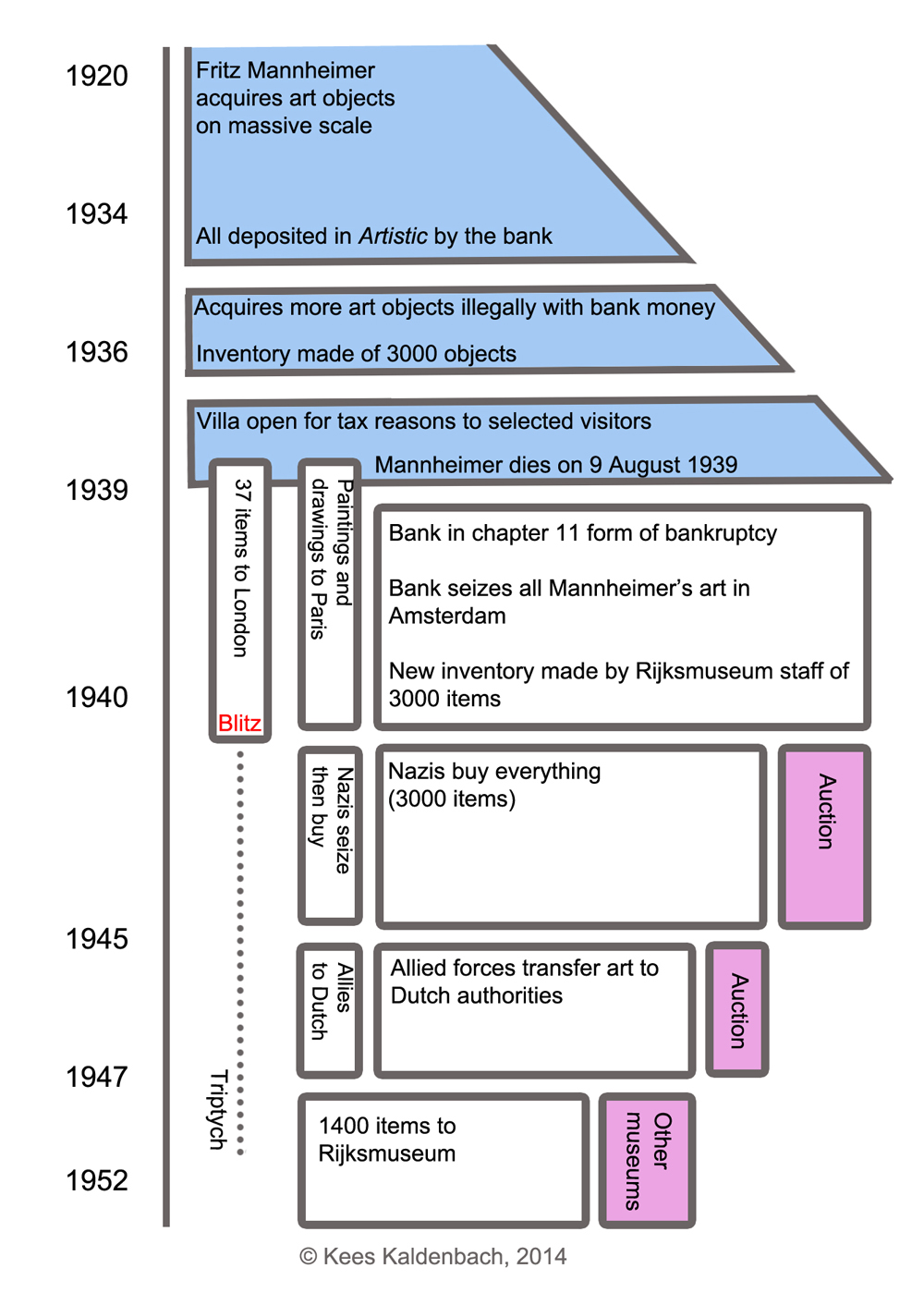

Above: Portraits of Dr F. Mannheimer, published by Haga in the Bulletin Rijksmuseum, 1974, p. 87.
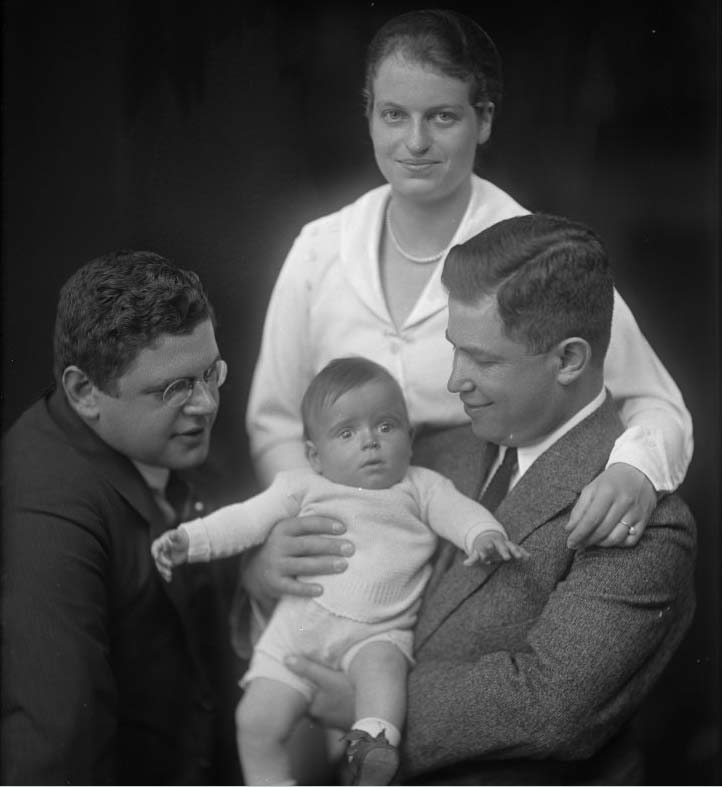
J.W. Merkelbach (photographer), Photo, 1919 showing Fritz Mannheimer (1890-1939), wearing glasses, with his brother Victor Mannheimer (1887-19??), his wife Alice Fraenkel (1894-19??) and their baby son Max Eugen Manfred Israel Mannheimer (1918-??).
Fritz and Victor were welcome guests in Castle De Haar in Haarzuilens, in 1932, 1934 and 1935 where the noble castle owners received VIP guests every year in September. The castle hostess was a member of the Rothschild family.
Victor was a book collector and he owned a Stradivarius violin. Max Mannheimer (the son) worked in Paris on behalf of Fritz Mannheimer until 1939, and was sent to Nazi camp Theresienstad but survived and emigrated to the USA, where the Stradivarius violin was sold off. Photograph dated 1919, and recently identified. Amsterdam, City Archive, inv. no. 010164019371.
http://redeenportret.nl/portret/3189b34a-60b7-11e2-b256-003048976c14
See also Mannheimer swimming on a Youtube film, note 17 (MS Word file: see link at the beginning of this online article).
Below: Lost for the Rijksmuseum. A bomb hit a bank vault in the London Blitz, London, on the night of 23-24 September 1940: the tryptich is now in Campion Hall. The full story of loss and retrieval is in the hagiography written by H.J.A. Sire, Father Martin D'Arcy: Philosopher of Christian Love, 1997 p. 147-148.

The one below: found in the rubble during the London blitz, picked up and bought later on for the Rijksmuseum:
Anonymous, initially attributed to Donatello, Boy, right hand on chest, nude sculpture, bronze, on a green marble base, originally from the Hermitage, inv. nr. BK-16946, was valued in 1948 at f 100,000 and acquired as late as 1960. It was picked up from the rubble after the Blitz bomb in London, on the night of 23-24 September 1940, see annex 4. See also Fig. 1. |
|

Reaction, questions?
Drs. Kees Kaldenbach, art historian, kalden@xs4all.nl Haarlemmermeerstraat 83hs, 1058 JS Amsterdam (near Surinameplein, ring road exit s106, streetcar tram 1 and 17).
Telephone 020 669 8119; cell phone 06 - 2868 9775.
Open seven days a week. Menu of Kaldenbach tours
Third party testimonials about Drs Kaldenbach
Amsterdam Chamber of Commerce (Kamer van Koophandel) number of Johannesvermeer.info / Lichaam & Ziel [ Body & Soul] is 3419 6612.
E mail esponses and bookings to art historian Drs. Kees Kaldenbach.
This page forms part of the 2000+ item Vermeer web site at www.xs4all.nl/~kalden
A private Rijksmuseum tour, VIP entry.
Launched December 3, 2014. Updated 23 september 2018
Dear Kees,
We are home now, much enlightened and pleased by your guidance [in the Rijksmuseum]. The trip to Kroller-Muller was very enjoyable and a high point of our visit in Holland.
I want to commend you on the Mannheim collection article which I read with great interest. It is a fascinating story, made a bit more interesting to us because we have a slight [personal] acquaintance with Annette (now de la Renta.)
Thank you again for your kindness and expertise.
best regards
Nick Ludington
An exceptional Rembrandt: Uyttenboogaard in the Rijksmuseum
Adriaen Coorte, by Quentin Buvelot, book & exhibition catalogue.
De Grote Rembrandt, door Gary Schwartz, boek.
Geschiedenis van Alkmaar, boek.
Carel Fabritius, Tentoonstellingscatalogus.
Frans van Mieris, Tentoonstellingscatalogus.
From Rembrandt to Vermeer, Grove Art catalogue, book.
Vermeer Studies, Congresbundel.
C. Willemijn Fock: Het Nederlandse interieur in beeld, boek.
Het Huwelijksgeschenk (1934), boek over de egoïstische vrouw, die haar luiheid botviert.
Zandvliet, 250 De Rijksten van de Gouden Eeuw , boek + nieuwe stippenplattegrond!
Ik doe wat ik doe, teksten van Lennaert Nijgh , boek + cd
Het Rotterdam Boek, boek.
Bouwen in Nederland 600 - 2000, boek.
Hollandse Stadsgezichten/ Dutch Cityscape, exhib. cat.
Zee van Land / over Hollandse Polders (NL) boek
Sea of Land / about Dutch Polders (English) book
A full article on the large portrait of the marvellous preacher Uytenboogaard.
Artikel over Uytenboogaerd, Nederlandse versie.
Geert Grote en het religieuze Andachtsbild
TEFAF 2008 art fair